ERYTHROMYCIN - OPHTHALMIC
PHONETIC PRONUNCIATION: (eh-rith-row-MY-sin)
COMMON BRAND NAME(S): Ilotycin
GENERIC NAME(S): erythromycin base
Uses
USES: This medication is used to treat certain eye infections (such as conjunctivitis). It is also used to prevent certain eye infections in newborns. It belongs to a class of drugs known as macrolide antibiotics. Erythromycin works by stopping the growth of bacteria. This medication treats only bacterial eye infections. It will not work for other types of eye infections. Unnecessary use or misuse of any antibiotic can lead to its decreased effectiveness.
How to use ERYTHROMYCIN - OPHTHALMIC
HOW TO USE: To apply eye ointment, wash your hands first. To avoid contamination, be careful not to touch the tip of the tube or let it touch your eye, eyelid, or any other surface. Apply to the eyes only. Do not swallow or inject. Do not wear contact lenses while you are using this medication. Sterilize contact lenses according to the manufacturer's directions, and check with your doctor before you begin using them again. To apply eye ointments, tilt your head back, look up, and gently pull down the lower eyelid to make a pouch. Place about a half-inch (1 centimeter) strip of ointment into the pouch as directed by your doctor. Gently close the eye and roll the eyeball in all directions to spread the medication. Try not to blink and do not rub the eye. Repeat these steps for your other eye if so directed. Wipe the tip of the ointment tube with a clean tissue to remove extra medication before recapping it. Wait several minutes for your vision to clear before driving or operating machinery. The dosage is based on your medical condition and response to treatment. Do not increase your dose or use it more often than directed. If you are using another kind of eye medication (such as drops or ointments), wait at least 5 minutes before applying other medications. Use eye drops before eye ointments to allow the drops to enter the eye. Use this medication regularly in order to get the most benefit from it. To help you remember, use it at the same times each day. Continue using it for the full time prescribed. Stopping the medication too soon may allow the bacteria to continue to grow, which may result in a return of the infection. Tell your doctor if your condition persists or worsens.
Side Effects
Precautions
Interactions
Overdose
Images
Reviews
Faq for ERYTHROMYCIN - OPHTHALMIC
Erythromycin ophthalmic is used to treat bacterial infections of the eye, including conjunctivitis and keratitis.
Erythromycin ophthalmic inhibits the growth of bacteria by interfering with their protein synthesis.
Common side effects may include eye irritation, stinging or burning sensation, blurred vision, and temporary blurred vision after applying the medication.
You should wash your hands before using the medication and apply it directly to the affected eye(s) as directed. Avoid touching the tip of the dropper to prevent contamination.
It is recommended to remove contact lenses before applying the medication. You can reinsert them 15 minutes after applying Erythromycin ophthalmic.
Follow the instructions provided by your doctor or pharmacist. It is usually recommended to use the medication for the prescribed duration, even if the symptoms improve.
Yes, Erythromycin ophthalmic can be used in children. However, it is important to consult a pediatrician for proper dosage instructions.
If you miss a dose, apply it as soon as you remember. If it is close to the time for your next dose, skip the missed dose and continue with your regular dosing schedule.
There are no significant drug interactions associated with Erythromycin ophthalmic. However, it is always advisable to inform your doctor or pharmacist about all the medications you are taking.
Disclaimer
IMPORTANT: HOW TO USE THIS INFORMATION: This is a summary and does NOT have all possible information about this product. This information does not assure that this product is safe, effective, or appropriate for you. This information is not individual medical advice and does not substitute for the advice of your health care professional. Always ask your health care professional for complete information about this product and your specific health needs.
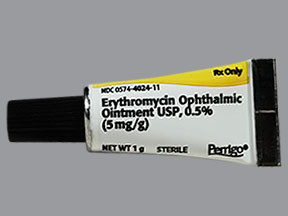
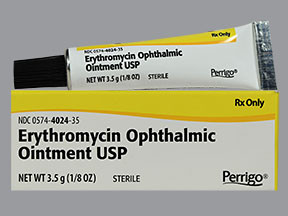
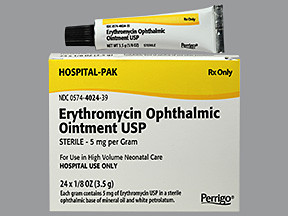
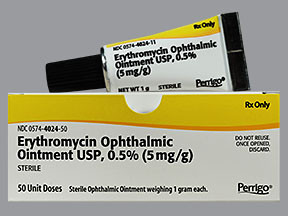

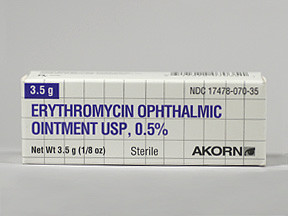
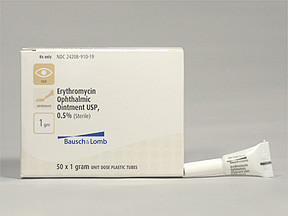
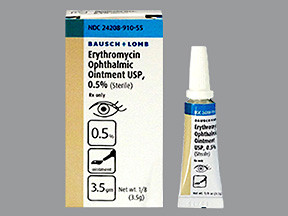

No Reviews Yet